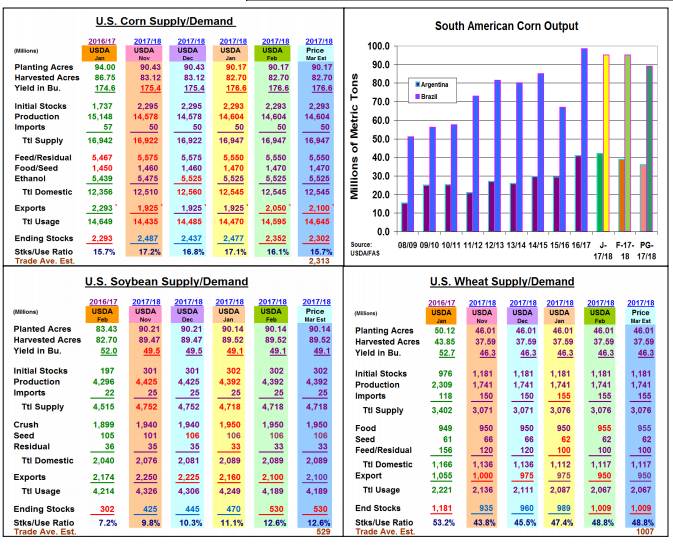Pre-USDA March Report
Market Analysis
The upcoming March World Production and Supply/Demand revisions will be released on March 8. The USDA hasn’t traditionally made many changes in their US & World Supply/Demand reports this month. The USDA usually likes to see its March quarterly stocks reports before making domestic demand changes. This year’s erratic S. American weather where Argentina has been in drought since late December while heavy rains have fallen during northern Brazil’s harvest may limit the USDA’s crop changes in both countries while also possibly delaying US demand changes to later this month.
Argentine concerns have already boosted US corn exports by 480 million bu. over the past 7 weeks (68.7 million weekly average). The USDA raised US export outlook by125 million bu. last month and may up it another 50-100 million this month given recent S. American talk. The trade is projecting another 3-4 mmt drop in Argentina’s corn crop vs. the USDA’s 39 mmt Feb. level. After Brazil’s Ag Ministry dropped its corn estimate to 89 mmt last month and this year’s Feb 23 safrina corn plantings in Mato Grasso were 10% slower than last year, the USDA may catch up to Brazil’s corn crop estimate this month. With US ethanol output similar to last winter and feed usage not normally adjusted till, after March’s stock report, no change in these demand levels are likely.
In soybeans, overseas sales continued to lag as Chinese purchases have been slow until the last few weeks. Brazil’s prospects have remained good while Argentina’s crop has worsened, but higher Argentine losses of 5-7 mmt are now being estimated. Despite these losses, the Chinese dissatisfaction with US bean quality and now the US steel & aluminum tariffs may prompt the USDA to leave its US soy demand level unchanged for now.
Despite bad HRW prospects, Black Sea crops rule prices. No big US wheat demand changes this month.

What’s Ahead
South American, US, and Black Sea weather concerns have bubbled up prices. However, recently proposed US steel and aluminum import tariffs and the resumption of the NAFTA talks has added price concerns to the pits. Under these conditions, producers should have old-crop sales at 85% in wheat, 90% in beans and 50% in corn with new-crop soybean and wheat coverage at 40-50% and corn at 20-30%.
Disclaimer – The information contained in this report reflects the opinion of the author and should not be interpreted in any way to represent the thoughts of The PRICE Futures Group, any of ...
more


